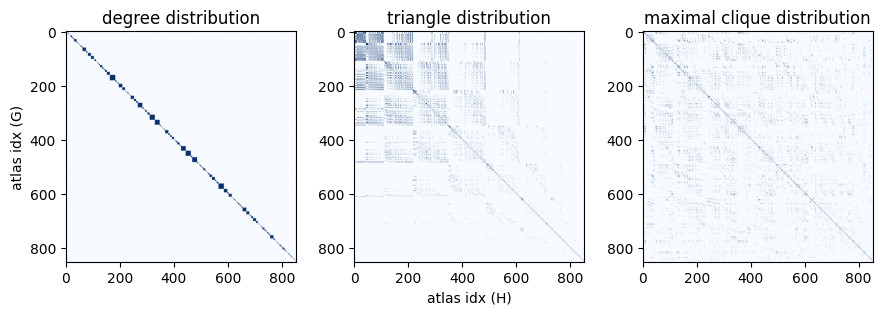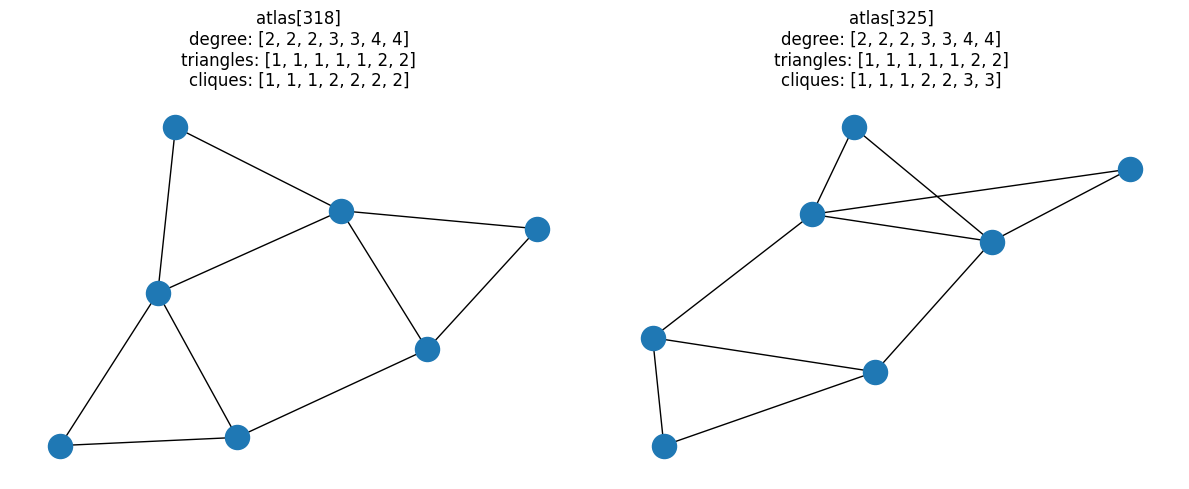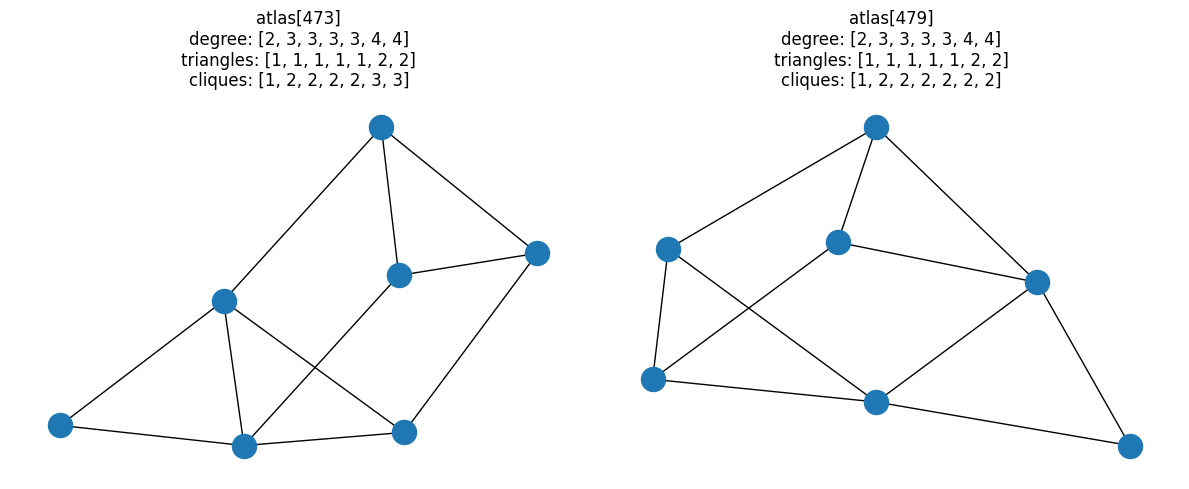To be or not to be (isomorphic)#
import networkx as nx
import numpy as np
import matplotlib.pyplot as plt
Graph isomorphism is a very interesting topic with many applications spanning graph theory and network science — check out the isomorphism tutorial for a deeper introduction!
Determining whether two graphs G and H are isomorphic essentially boils
down to finding a valid isomorphic mapping between the nodes in G and H,
respectively.
The process of finding such a mapping can be quite expensive.
Let’s investigate with a basic pair of graphs.
G = nx.complete_graph(100)
H = nx.relabel_nodes(G, {n: 10 * n for n in G})
We know G and H are isomorphic a priori, since H is just a copy of G with
relabeled nodes.
Of course, we can verify this:
nx.is_isomorphic(G, H)
True
and do some basic timing to get a sense of how long it takes to make this determination:
%timeit -n1 -r1 nx.is_isomorphic(G, H)
74 ms ± 0 ns per loop (mean ± std. dev. of 1 run, 1 loop each)
Not too bad, at least for these relatively small simple graphs - but absolute timing values aren’t particularly informative. How does this compare with a very similar example where the graphs are not isomorphic?
H_ni = G.copy()
H_ni.remove_edge(27, 72) # Remove a single arbitrary edge
Again, we know a priori that G and H_ni are not isomorphic:
nx.is_isomorphic(G, H_ni)
False
but even though all we’ve done is remove a single arbitrary edge from H, the
isomorphism determination is several orders of magnitude faster!
%timeit -n1 -r1 nx.is_isomorphic(G, H_ni)
129 μs ± 0 ns per loop (mean ± std. dev. of 1 run, 1 loop each)
Quantitatively:
import timeit
iso_timing, non_iso_timing = (
timeit.timeit(f"nx.is_isomorphic(G, {G2})", number=20, globals=globals())
for G2 in ("H", "H_ni")
)
print(f"Relative compute time, iso/non_iso example: {iso_timing/non_iso_timing:.2f}")
Relative compute time, iso/non_iso example: 1086.22
At face value it may seem surprising that two cases which are so similar can result in such drastic differences in computation time.
The only way to prove that two graphs are isomorphic is to find a valid
isomorphic mapping between them — in the worst-case scenario, this could
entail searching every possible mapping of nodes between G and H!
Graphs that are isomorphic however are guaranteed to have certain properties.
For example, isomorphic graphs must have identical degree distributions.
If two graphs are shown to have different degree distributions, then we can
definitively say they are not isomorphic, without having to have
tested a single potential node mapping between G and H.
However - neither is showing that two graphs have the same degree distribution
sufficient to prove that they are isomorphic!
This asymmetry is the motivation for the nx.could_be_isomorphic
function, which compares various properties of pairs of graphs to determine
whether they, well, could be isomorphic.
There are many properties of graphs that one could compare, ranging from the
trivial (i.e. the number of nodes) to more complex features like average
clustering.
nx.could_be_isomorphic has four built-in property checks:
The order of the graphs (i.e. the number of nodes)
The degree of each node
The number of triangles that each node contributes to in the graph
The number of maximal cliques that each node contributes to in the graph
Exploring properties on the graph atlas#
So - we have properties of graphs that we can compare to determine whether or
not two graphs may be isomorphic.
We also know that some properties are more expensive to compute than others.
An obvious next question then is: how “good” are these various properties
in filtering out non-isomorphic graphs?
For instance, if degree distribution alone is sufficient to prove that two graphs
are not isomorphic in the vast majority of cases, then a good rule of thumb
might be to test degree distribution first in could_be_isomorphic, since the
degree distribution is so quick to compute (compared to triangles or cliques).
Answering this question in general is probably not possible, but perhaps we
can build some intuition by exploring the question on a manageable set of
possible graphs.
For example, we can use the nx.graph_atlas_g to investigate these
properties on all fully-connected simple graphs with 7 nodes.
atlas = nx.graph_atlas_g()[209:] # Graphs with 7 nodes start at idx 209
print(f"{len(atlas)} graphs with 7 nodes.")
# Limit analysis to fully-connected graphs
atlas = [G for G in atlas if nx.number_connected_components(G) == 1]
print(f"{len(atlas)} fully-connected graphs with 7 nodes.")
1044 graphs with 7 nodes.
853 fully-connected graphs with 7 nodes.
Now let’s examine the properties of these graphs. Let’s define a few property-extraction shortcuts to save ourselves some typing:
from itertools import chain
from collections import Counter
degree = lambda G: sorted(d for _, d in G.degree())
triangles = lambda G: sorted(nx.triangles(G).values())
cliques = lambda G: sorted(Counter(chain.from_iterable(nx.find_cliques(G))).values())
# Map each callable to a more detailed name - this will be useful for e.g.
# labeling plots
name_property_mapping = {
"degree distribution": degree,
"triangle distribution": triangles,
"maximal clique distribution": cliques,
}
And from here, let’s compare the graphs to each other! The simplest way to do so is simply to brute-force compare each graph to every other:
def property_matrix(property):
"""`property` is a callable that returns the property to be compared."""
return np.array(
[[property(G) == property(H) for H in atlas] for G in atlas],
dtype=bool,
)
Let’s start with some sanity-checking.
From the definition of the graph atlas, we’d expect that none of the graphs
are isomorphic with any other (except with themselves).
If we translate this expectation to our property_matrix, we’d expect the
isomorphic property matrix to be the identity matrix - i.e. with the only
True values lying along the diagonal.
is_iso = np.array([[nx.is_isomorphic(G, H) for H in atlas] for G in atlas], dtype=bool)
np.array_equal(is_iso, np.eye(len(atlas), dtype=bool))
True
Sanity-check passed — now let’s move on to the property comparison:
import time
p_mats = []
for name, property in name_property_mapping.items():
# Do some (very) rough timing of the property computation
tic = time.time()
pm = property_matrix(property)
toc = time.time()
print(f"{toc - tic:.3f} sec to compare {name} for all graphs")
p_mats.append(pm)
# Unpack results
same_d, same_t, same_c = p_mats
4.163 sec to compare degree distribution for all graphs
39.512 sec to compare triangle distribution for all graphs
51.723 sec to compare maximal clique distribution for all graphs
Let’s look at the rough timing first.
Again, we have to be careful about drawing general conclusions because we’re
only working with such a small subset of graphs.[1]
That being said, we note that computing/comparing degree distribution is
roughly an order of magnitude faster than cliques or triangles, which are
(at least for these graphs) of the same order in terms of computation time.
How about the properties themselves:
fig, ax = plt.subplots(1, 3, figsize=(9, 3))
for a, pname, pm in zip(ax, name_property_mapping, p_mats):
a.imshow(pm, cmap=plt.cm.Blues)
a.set_title(pname)
ax[1].set_xlabel("atlas idx (H)")
ax[0].set_ylabel("atlas idx (G)")
fig.tight_layout()

One thing that immediately jumps out is that all graphs with identical
degree distribution appear to be organized such that they are adjacent to
each other.
A closer look at the nx.graph_atlas_g docstring explains why:
degree sequence is one of the properties by which the graphs are sorted in
the atlas.
Another thing we might notice is that the graph pairs with identical triangle distributions are concentrated towards the upper-left corner of the matrix. This too makes sense — the atlas is ordered by (among other things) increasing degree sequence. Therefore the graphs with the lowest indices have the smallest values in degree sequence. A triangle requires at least 3 nodes to have degree of at least 2 - which means the upper-left corner of the matrix contains all the graph pairs where there are no triangles, with the propensity for triangles generally increasing with increasing degree distribution (from upper left to lower right).
Let’s quantify the results. Of the 853 fully-connected graphs of 7 nodes, how many of them have them have the same properties? We can sum over the property masks to answer this question, though we have to remember to:
Ignore the diagonal, i.e. don’t include the comparison of each graph with itself, and
We were lazy in the computation of the properties and ended up comparing each graph to each other twice (i.e.
GtoHandHtoG), so we also need to account for that.
import pandas as pd
num_same = {
f"Same {pname}": (pm & ~is_iso).sum() // 2
for pname, pm in zip(name_property_mapping, p_mats)
}
# Use pandas to get a nice html rendering of our tabular data
pd.DataFrame.from_dict(num_same, orient="index")
| 0 | |
|---|---|
| Same degree distribution | 3048 |
| Same triangle distribution | 9696 |
| Same maximal clique distribution | 6437 |
We can also look at combinations of properties - for example: the number of graphs that have the same degree distribution and triangle distribution:
same_dt = same_d & same_t & ~is_iso
print(
f"Number of graph pairs with same degree and triangle distributions: {same_dt.sum() // 2}"
)
Number of graph pairs with same degree and triangle distributions: 270
That’s a pretty strong filter! The total number of non-isomorphic pairs of fully-connected graphs of 7 nodes is: \(\frac{853^{2} - 853}{2} = 363378\). Filtering by degree, triangles, or cliques alone results in several thousand candidates, but combining properties makes for an even stronger filter in determining whether graphs could be isomorphic.
Let’s take a look at some of these graph pairs.
candidates = zip(*np.where(same_dt))
# Filter out the duplicates
graph_pairs = []
seen = set()
for pair in candidates:
if pair[::-1] not in seen:
graph_pairs.append(pair)
seen.add(pair)
fig, ax = plt.subplots(1, 2, figsize=(9, 3))
# First pair of graphs with same degree and triangle distributions
pair = graph_pairs[0]
G, H = (atlas[idx] for idx in pair)
for idx, a in zip(pair, ax):
G = atlas[idx]
nx.draw(G, ax=a)
a.set_title(f"atlas[{idx}]\ndegree: {degree(G)}\ntriangles: {triangles(G)}")
fig.tight_layout()
nx.could_be_isomorphic(G, H, properties="dt")
True

This matches our expectations, and is a nice illustration of how checking properties is not sufficient to prove graphs are isomorphic. It’s a little boring though as there are no triangles - let’s look at a pair where the graphs contain triangles:
fig, ax = plt.subplots(1, 2, figsize=(9, 3))
# Last pair of graphs with same degree and triangle distributions
pair = graph_pairs[-1]
for idx, a in zip(pair, ax):
G = atlas[idx]
nx.draw(G, ax=a)
a.set_title(f"atlas[{idx}]\ndegree: {degree(G)}\ntriangles: {triangles(G)}")
fig.tight_layout()

Let’s refine our investigation even further — of the 363378 possible graph pairs, how many have identical combined degree-triangle distributions, but different clique distributions? In other words, for how many of these graph pairs is the distribution of maximal cliques the determining factor in whether or not the graphs could be isomorphic?
Let’s start by combining our masks computed from properties independently to constrain the search space:
diff_c = same_d & same_t & ~same_c & ~is_iso
print(
"Number of graph pairs with same degree and triangle distributions\n"
f"but different clique distributions: {diff_c.sum() // 2}"
)
candidates = zip(*np.where(diff_c))
# Filter out the duplicates
graph_pairs = []
seen = set()
for pair in candidates:
if pair[::-1] not in seen:
graph_pairs.append(pair)
seen.add(pair)
Number of graph pairs with same degree and triangle distributions
but different clique distributions: 107
Here’s the “simplest” of these candidate pairs, i.e. the pair with the lowest degree sequence:
fig, ax = plt.subplots(1, 2, figsize=(9, 3))
# Last pair of graphs with same degree and triangle distributions
pair = graph_pairs[0]
for idx, a in zip(pair, ax):
G = atlas[idx]
nx.draw(G, ax=a)
a.set_title(
f"atlas[{idx}]\ndegree: {degree(G)}\ntriangles: {triangles(G)}\ncliques: {cliques(G)}"
)
fig.tight_layout()

At this point, we’ve filtered down all the possible combinations of fully-connected
7-node graphs to 107 candidates that have the same degree distributions,
triangle distributions, and different clique distributions.
However - recall that to this point we have only compared the properties
independently - i.e. we compared the sorted degree sequences, then the sorted
triangle distributions etc.
This is less-restrictive than if we had considered the combined properties of
the nodes.
In other words, rather than comparing degree, then triangles - what if we compute
the degree and number of triangles for each node, then sort the nodes
based on this combined degree-and-number-of-triangles feature.
could_be_isomorphic compares the combined properties, so
we can answer our question by applying it to our candidate pairs:
# All graph pairs that have the same *combined* degree-and-triangle distributions
# but a different clique distributions
resulting_pairs = [
(int(G), int(H))
for (G, H) in graph_pairs
if nx.could_be_isomorphic(atlas[G], atlas[H], properties="dt")
]
resulting_pairs
[(318, 325), (473, 479)]
Of all fully-connected graphs with 7 nodes, there are only two unique pairs of graphs that have the same degree-and-triangle combined properties, but different clique distributions.
for i, pair in enumerate(resulting_pairs):
fig, ax = plt.subplots(1, 2, figsize=(12, 5))
for idx, a in zip(pair, ax):
G = atlas[idx]
nx.draw(G, ax=a)
a.set_title(
f"atlas[{idx}]\ndegree: {degree(G)}\ntriangles: {triangles(G)}\ncliques: {cliques(G)}"
)
fig.tight_layout()


Inspiration#
You may be wondering what motivated this particular line of investigation.
This analysis was originally performed in order to find
test cases for nx.could_be_isomorphic.
